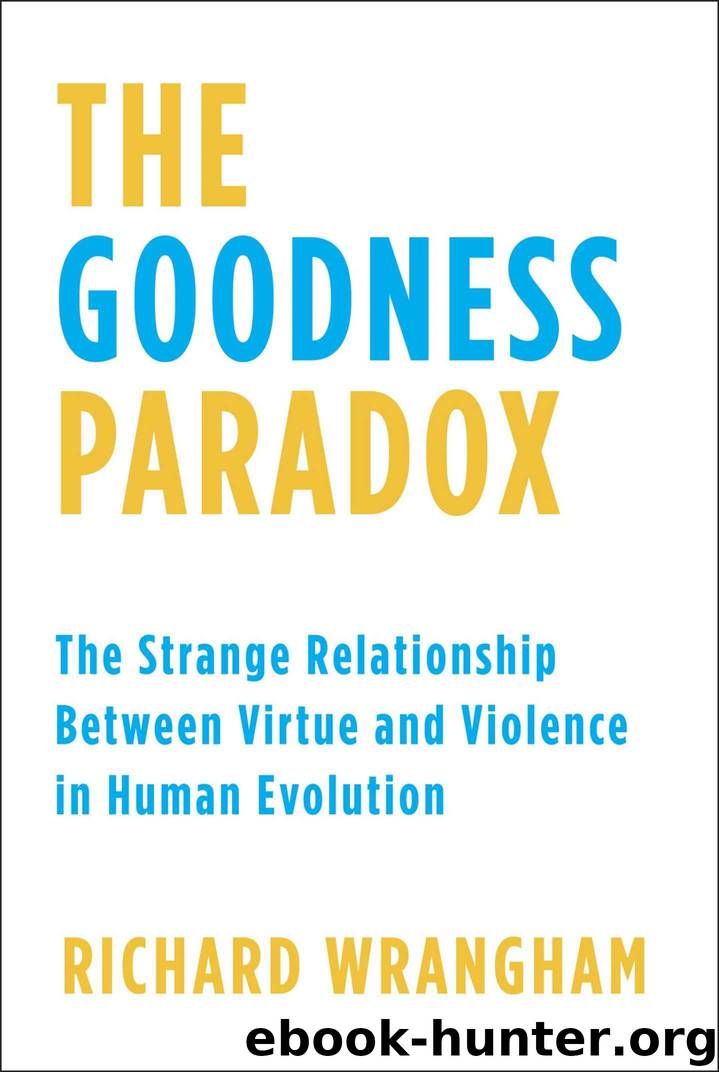The Goodness Paradox by Wrangham Richard

Author:Wrangham, Richard [Wrangham, Richard]
Language: eng
Format: azw3, epub
Publisher: Knopf Doubleday Publishing Group
Published: 2019-01-28T16:00:00+00:00
* * *
—
That domesticated animals cooperate better than their wild ancestors is shown by research on “cooperative communication,” which refers to understanding the deliberate sharing of useful information. An interesting take on cooperative communication is to look beyond communication within a species to communication between species, which has been studied by finding out whether animals understand helpful signals given by humans. Is this useful cognitive skill purely a matter of intelligence, or might it be linked to domestication? Starting in 2002, Brian Hare began testing several species. Dogs were the easiest subjects.48
A typical test, the so-called object-choice test, begins with admitting a dog into a room where an experimenter is standing at an equal distance from two upside-down bowls on the floor. The bowls are identical, but under one of them a food treat lies hidden. The person points to one of the upside-down bowls. A successful dog understands that the person is trying to help and goes to the indicated bowl. Hare and a small team of researchers found that most dogs passed this test. For dog lovers, this was not a big surprise. What was interesting was that wolves failed the test.
Even chimpanzees cannot normally pass the object-choice test. Chimpanzees are generally better at solving problems than dogs, but they did not solve this one. The communicative-cooperative ability was special to dogs.
Dogs, by contrast to chimpanzees, passed the test not only as adults but even as puppies a few weeks old. This was evidence that the communicative-cooperative understanding of dogs is genetically grounded, not a learned capacity.
There are two possible explanations for dogs’ doing better than wolves and chimpanzees, depending on what domestication did.
One possibility is that, during the process of domestication, dogs had been selected specifically for their ability to read human social cues. That is the tempting inference, because it is easy to imagine that dog breeders would favor the dogs that were most cooperative.
The alternative idea is that the cooperative-communicative ability was not selected for, but, rather, that an improved ability to read human signals emerged simply as an unselected by-product of the process of domestication. In this case, cooperative-communicative ability would be part of the domestication syndrome.
Belyaev’s work with foxes offered a way to test between the two explanations. The domesticated line of foxes had been selected for reduced emotional reactivity, but they had never been selected for their ability to communicate with humans. If the domesticated foxes could read human signals even though they had never been selected to do so, then the cooperative-communicative ability must be a by-product of the domestication process.49
By 2003, Lyudmila Trut was the director of Belyaev’s research station at Novosibirsk, in southwestern Siberia. With her help, Brian Hare tested the foxes that Belyaev and Trut had experimentally domesticated. He performed the same tests with a control line of unselected foxes that had been reared and housed in the same way as the domesticated line.
The result was lovely. The domesticated foxes behaved like dogs. They tended to follow human signals.
Download
This site does not store any files on its server. We only index and link to content provided by other sites. Please contact the content providers to delete copyright contents if any and email us, we'll remove relevant links or contents immediately.
| Amphibians | Animal Behavior & Communication |
| Animal Psychology | Ichthyology |
| Invertebrates | Mammals |
| Ornithology | Primatology |
| Reptiles |
Sapiens: A Brief History of Humankind by Yuval Noah Harari(14252)
The Tidewater Tales by John Barth(12608)
Mastermind: How to Think Like Sherlock Holmes by Maria Konnikova(7227)
Do No Harm Stories of Life, Death and Brain Surgery by Henry Marsh(6891)
The Thirst by Nesbo Jo(6826)
Why We Sleep: Unlocking the Power of Sleep and Dreams by Matthew Walker(6618)
Life 3.0: Being Human in the Age of Artificial Intelligence by Tegmark Max(5474)
Sapiens by Yuval Noah Harari(5294)
The Longevity Diet by Valter Longo(5019)
The Body: A Guide for Occupants by Bill Bryson(4974)
The Rules Do Not Apply by Ariel Levy(4861)
The Immortal Life of Henrietta Lacks by Rebecca Skloot(4525)
Animal Frequency by Melissa Alvarez(4395)
Why We Sleep by Matthew Walker(4360)
The Hacking of the American Mind by Robert H. Lustig(4318)
Yoga Anatomy by Kaminoff Leslie(4306)
All Creatures Great and Small by James Herriot(4232)
Double Down (Diary of a Wimpy Kid Book 11) by Jeff Kinney(4207)
Barron's AP Biology by Goldberg M.S. Deborah T(4097)
